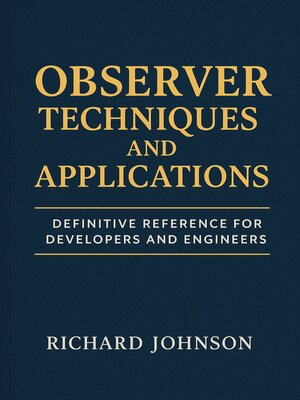Observer Techniques and Applications
ebook ∣ Definitive Reference for Developers and Engineers
By Richard Johnson

Sign up to save your library
With an OverDrive account, you can save your favorite libraries for at-a-glance information about availability. Find out more about OverDrive accounts.
Find this title in Libby, the library reading app by OverDrive.



Search for a digital library with this title
Title found at these libraries:
| Library Name | Distance |
|---|---|
| Loading... |
"Observer Techniques and Applications"
"Observer Techniques and Applications" offers a comprehensive exploration of state estimation theory, blending fundamental principles with advanced methods and real-world applications. The book begins by establishing a solid foundation in observer design, tackling the key concepts of observability, controllability, and state-space modeling, before delving into classical linear observers and the rigorous mathematical tools that underpin modern observer analysis. It thoughtfully examines stability criteria through Lyapunov methods and addresses the practical computational challenges involved in implementing both continuous and discrete observers.
Building on this foundation, the volume covers an impressive breadth of observer strategies—including stochastic and Bayesian estimation methods such as Kalman filtering, particle filtering, and sensor fusion, as well as nonlinear observer techniques like high-gain, adaptive, and sliding mode observers. Readers will find in-depth discussions on distributed and networked observers, designed for today's interconnected systems, as well as specialized coverage of observers for hybrid, infinite-dimensional, and complex networked environments. Each chapter couples theoretical development with engineering considerations, illuminating robust approaches for uncertain, time-varying, and cyber-physical systems.
The book's scope extends to a broad array of application domains, demonstrating observer utility in industrial automation, robotics, automotive and aerospace systems, biomedical engineering, and smart grids. It bridges theory and practice with chapters on software realization, high-performance computing for observers, and verification strategies for real-time deployment. Closing with a forward-looking perspective, "Observer Techniques and Applications" surveys emerging frontiers in machine learning, privacy, security, and quantum-inspired designs—making it an indispensable resource for researchers, engineers, and advanced students developing next-generation estimation solutions.







